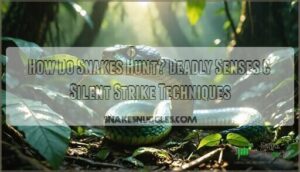This site is supported by our readers. We may earn a commission, at no cost to you, if you purchase through links.

They detect your heartbeat through ground vibrations, track your body heat with built-in thermal cameras, and follow your scent trail with their forked tongues acting like chemical detectors.
When they strike, it’s game over in milliseconds, as venomous species inject cocktails of toxins that shut down your nervous system, while constrictors squeeze with bone-crushing force that stops blood flow instantly.
Their jaws unhinge like a horror movie, allowing them to swallow prey twice their head size, revealing sophisticated adaptations that make Hollywood monsters look amateur, and showcasing their ability to hunt with bone-crushing force and thermal cameras.
Table Of Contents
- Key Takeaways
- How Do Snakes Hunt?
- Prey Detection Strategies
- Prey Subjugation Strategies
- Specialized Feeding Structures
- Correlation Between Prey Difficulty and Adaptations
- Frequently Asked Questions (FAQs)
- Do snakes coordinate their hunts?
- How to hunt dangerous snakes in Snake City?
- What type of prey does a snake Hunt?
- Do snakes hunt in packs?
- What is the method of snake hunting?
- Do snakes hunt by smell?
- How to tell if a snake is hunting?
- What are the two methods snakes use for killing prey?
- How do snakes prey?
- Do snakes actively hunt?
- Conclusion
Key Takeaways
- You can’t hide from a snake’s multi-sensory detection system—they’ll feel your footsteps through ground vibrations up to 600 feet away, track your body heat with specialized pit organs, and follow your scent trail using their forked tongues like chemical GPS.
- You’re facing two deadly killing methods when snakes strike—venomous species inject paralyzing toxin cocktails through hollow fangs, while constrictors wrap around you with bone-crushing force that cuts off blood circulation and causes cardiac arrest.
- You’ll discover snakes are solo hunters who’ve mastered both ambush tactics and active pursuit, coiling motionless for hours or chasing prey at high speeds depending on their hunting strategy and environment.
- You’re witnessing millions of years of evolutionary perfection—snakes have developed specialized feeding structures like unhinging jaws, thermal-sensing pits, and fang morphology that’s perfectly adapted to their specific prey and hunting challenges.
How Do Snakes Hunt?
You’ll find snakes are masters of silent hunting strategies, using sophisticated sensory adaptations for prey detection.
These solitary hunters rely on ambush tactics in diverse hunting environments, detecting vibrations, heat signatures, and chemical trails.
Through seasonal hunting patterns and specialized foraging techniques, snake hunting combines stealth with precision—whether they’re coiled motionless or actively pursuing their next meal.
Prey Detection Strategies
You can’t hide from a snake’s incredible sensory toolkit – they’ve turned vibrations, heat, chemicals, and movement into a deadly detection system that puts your smartphone to shame.
These serpentine hunters combine multiple senses like a biological radar system, creating a detailed map of their surroundings that reveals every potential meal within striking distance, utilizing their incredible sensory toolkit.
Vibration Detection
Despite lacking external ears, you’d be amazed how snakes turn their entire body into a sophisticated detection system.
You’d never guess that a snake’s entire body functions as one massive, living seismic detector.
Their inner ear structures work with their jawbone as a conduit, picking up ground vibrations from prey movement up to 600 feet away. Snakes also utilize their tongues and Jacobson’s organ to process airborne scent molecules.
Here’s how this vibration detection works:
- Substrate influence affects transmission efficiency across different hunting environments
- Jawbone conduit transfers ground vibrations directly to inner ear components
- Movement detection serves dual purposes for both hunting success and predator avoidance
Heat Detection
Beyond feeling ground vibrations, you’ll discover that some snakes possess an extraordinary superpower: heat detection. Picture having thermal vision that works like a heat-seeking missile in complete darkness.
Here’s how these silent hunters evolved their thermal targeting systems:
- Pit vipers developed specialized pit organs between their eyes and nostrils
- Pythons and boas feature heat-sensitive pits along their lip scales
- These organs detect infrared radiation from warm-blooded prey up to 40 centimeters away
Snakes use their pit organ membrane to detect thermal variations. This nocturnal hunting advantage lets them defeat any thermal camouflage nature provides.
Chemical Detection
Heat sensing gives snakes a thermal advantage, but their chemical sensing abilities are the real game-changer.
When you watch a snake’s tongue flicking in and out, you’re witnessing nature’s most sophisticated chemical detection system. Those scent particles get analyzed by the Jacobson’s organ, creating a detailed chemical map of their surroundings.
Snakes also use ground vibrations to locate their prey.
This chemical sensing superpower allows snakes to:
- Track prey trails – Following scent particles like breadcrumbs through grass and soil
- Identify specific prey types – Distinguishing between mouse, bird, or frog chemical cues
- Navigate complex environments – Using chemical signals as an invisible GPS system
Visual and Movement Detection
Beyond chemical signals, snakes rely heavily on visual tracking for successful hunts.
While you might assume they’re nearly blind, their motion sensitivity is razor-sharp.
Tree snakes possess exceptional visual acuity with specialized pupil shapes that enhance depth perception.
Their light adaptation allows hunting in various conditions, making movement detection their secret weapon.
Here’s how their sensory adaptations optimize prey detection:
- Horizontal pupils provide wider fields of vision
- Enhanced contrast detection spots camouflaged prey
- Rapid eye movements track fast-moving targets
Prey Subjugation Strategies
Once you’ve spotted your prey, you’ll need more than sharp eyes to secure your next meal.
The hunt begins with detection, but victory demands the perfect kill.
Snakes employ two main tactics to overpower their victims: they either inject deadly venom through specialized fangs, or they use their powerful muscles to squeeze the life out of their prey through constriction.
Venom Injection
After pinpointing their target, venomous snakes release their most sophisticated weapon: venom injection. You’re witnessing millions of years of evolutionary perfection in action. Snake venom isn’t just poison—it’s a precisely engineered cocktail of toxins designed for prey immobilization.
Fang morphology varies dramatically across species, each adapted for specific hunting needs:
- Hollow fangs work like biological syringes, delivering venom deep into tissue
- Grooved fangs channel toxins along surface grooves during the bite
- Fixed fangs remain permanently erect, ready for instant venom delivery
- Folding fangs rotate forward during strikes, maximizing penetration depth
Venom composition targets different biological systems depending on prey specificity and snake defenses requirements.
Constriction
Constrictors like boas and pythons showcase nature’s most effective prey subjugation technique through muscular strength and precise coiling strategies.
When you witness snake constriction, you’re seeing millions of years of evolutionary advantages at work.
These powerful predators strike first, securing prey with needle-sharp teeth, then deploy muscular coils in a deadly embrace.
Here’s how constriction mechanics deliver prey suffocation:
- Lightning-fast strike secures the target with backward-curved teeth
- Muscular coils wrap around critical areas, cutting off blood circulation
- Pressure increases with each prey exhale until cardiac arrest occurs
Specialized Feeding Structures
Evolution’s toolbox gets wild when you peek at specialized feeding structures. Some snakes sport modified teeth that work like precision instruments—snail-eating species developed jaw morphology that extracts prey from shells like a surgeon.
Sea snakes evolved tiny heads with elongated necks, perfect for reef hunting. The mysterious tentacled snake boasts facial appendages whose function puzzles scientists.
Snakes’ diets are diverse, including fish as food. These adaptations showcase nature’s creativity:
- Snake fangs range from grooved teeth to tubular delivery systems
- Scale reduction enhances movement efficiency during hunts
- Thermal regulation affects feeding activity patterns
- Tentacle function remains an evolutionary mystery worth solving
Correlation Between Prey Difficulty and Adaptations
Understanding prey difficulty reveals nature’s most impressive evolutionary arms race between predators and their targets.
You’ll discover that snake hunting strategies directly mirror the challenges their prey presents, creating a perfect balance of adaptation trade-offs.
The correlation between prey difficulty and snake adaptations follows predictable patterns:
- Simple prey, simple tools – Blind snakes hunting soft-bodied termites need only basic equipment: reduced eyes and small teeth work perfectly in dark tunnels.
- Challenging prey, advanced arsenal – Rattlesnakes targeting quick mammals deploy sophisticated sensory adaptations: heat-sensing pits, potent venom, and specialized fangs.
- Extreme environments, extreme solutions – Sea snakes chasing agile fish evolved paddle-like tails and sealed nostrils for underwater hunting success.
This dietary specialization demonstrates how morphological constraints shape evolutionary adaptations.
Cave dwelling snakes, for instance, utilize heat sensitive receptors to hunt in complete darkness.
When prey becomes faster, more defensive, or harder to locate, snakes respond with increasingly specialized snake predation techniques.
It’s nature’s version of an arms race, where survival depends on staying one step ahead.
Frequently Asked Questions (FAQs)
Do snakes coordinate their hunts?
Ever wonder if serpents team up like wolf packs?
You’ll find that snakes are strictly solo hunters, relying on individual stealth and precision.
They don’t coordinate attacks or share prey—it’s every snake for itself, with each operating independently as a solo hunter.
How to hunt dangerous snakes in Snake City?
You’ll need specialized equipment, professional training, and proper permits before attempting snake removal in urban areas.
Contact licensed wildlife control experts instead—they’ve got the skills, tools, and antivenom access you lack.
What type of prey does a snake Hunt?
Snakes aren’t picky eaters—you’ll find them targeting rodents, birds, frogs, fish, eggs, and insects. They’ll hunt anything from tiny invertebrates to mammals twice their body width, swallowing prey whole.
Do snakes hunt in packs?
No, you won’t find snakes forming hunting parties like wolves.
These solitary predators prefer the lone wolf approach, relying on stealth and individual skill rather than teamwork to catch their next meal.
What is the method of snake hunting?
You’ll discover snakes use two main hunting methods: ambush tactics and active pursuit.
They’ll strike from hiding spots, chase prey at high speeds, or constrict victims using powerful coils to stop blood flow, which can be considered an ambush tactic.
Do snakes hunt by smell?
Their forked tongues collect scent particles from the air, which get analyzed by the Jacobson’s organ in their mouth.
This chemical detection system is their primary hunting tool for tracking prey.
How to tell if a snake is hunting?
Like a coiled spring ready to strike, you’ll spot a hunting snake by its stillness and focus.
Watch for tongue flicking, alert posture, and motionless positioning near prey trails or hiding spots.
What are the two methods snakes use for killing prey?
Snakes kill prey using two primary methods: venom injection through specialized fangs that deliver toxins to immobilize victims.
Or constriction where powerful coils squeeze around prey to stop blood flow to essential organs, using constriction as an alternative method.
How do snakes prey?
Picture a rattlesnake coiled beneath desert brush, waiting motionless for hours until an unsuspecting mouse wanders close.
You’ll find snakes use ambush tactics or active pursuit, detecting prey through heat, vibrations, and chemical trails, which is a key aspect of their active pursuit.
Do snakes actively hunt?
Yes, you’ll find that snakes actively hunt using two main strategies: ambush predation where they wait motionlessly for prey.
They also use active pursuit where species like racers chase down their targets at impressive speeds.
Conclusion
Understanding how snakes hunt reveals nature’s most efficient predators in action.
You’ve discovered their incredible sensory arsenal—from detecting your footsteps through ground vibrations to tracking your body heat like living thermal cameras.
Their forked tongues taste molecules in the air, creating detailed scent maps of potential prey.
Whether they’re injecting paralyzing venom or applying bone-crushing constriction, snakes have perfected hunting techniques that would make any apex predator jealous of their silent, deadly precision.














